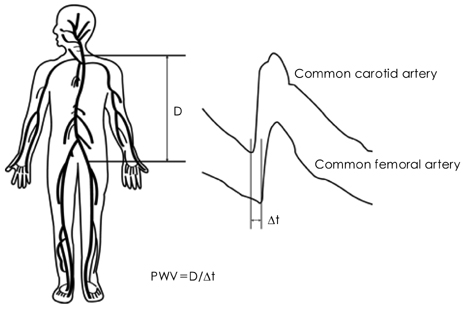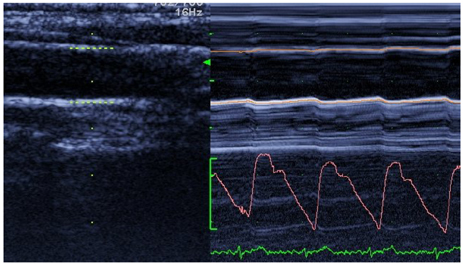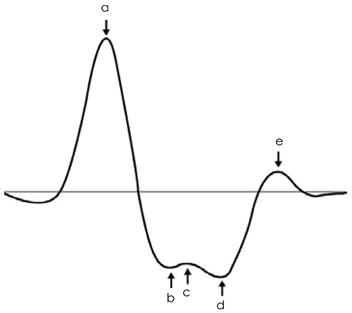Korean Circ J.
2008 Jul;38(7):343-350. 10.4070/kcj.2008.38.7.343.
Measurements of Arterial Stiffness: Methodological Aspects
- Affiliations
-
- 1Department of Internal Medicine, Dongguk University College of Medicine, Gyeongju, Korea. mooyong_rhee@duih.org
- 2Department of Internal Medicine, Seoul National University Hospital, Seoul, Korea.
- 3Department of Medicine/Cardiology, Cheil General Hospital, Kwandong University College of Medicine, Seoul, Korea.
- KMID: 2225766
- DOI: http://doi.org/10.4070/kcj.2008.38.7.343
Abstract
- A significant association between increased arterial stiffness and the development of cardiovascular disease has led to the increased use of arterial stiffness in the clinical assessment of cardiovascular risk. Various methods are currently available. With advances in technology, the assessment methods have become easy to use and more acceptable to patients. However, the different techniques that are available measure arterial stiffness at different locations and have unique indices for arterial stiffness. For the appropriate assessment of arterial stiffness, accurate and reproducible measurements of arterial stiffness are essential. Here we review the methodological aspects of the measurement of arterial stiffness and provide information on the measurement methods available and their clinical applications.
Keyword
MeSH Terms
Figure
Cited by 2 articles
-
Evaluation of Arterial Stiffness by Echocardiography: Methodological Aspects
Jae Yeong Cho, Kye Hun Kim
Chonnam Med J. 2016;52(2):101-106. doi: 10.4068/cmj.2016.52.2.101.Effect of Rheumatoid Factor on Vascular Stiffness in General Population without Joint Symptoms
Ji Hyun Lee, Hee Sang Tag, Geun Tae Kim, Min Jeong Kim, Seung Geun Lee, Eun Kyung Park, Dong Wa Koo
Kosin Med J. 2017;32(1):25-35. doi: 10.7180/kmj.2017.32.1.25.
Reference
-
1. Nichols WN, O'Rourke MF. Macdonald's Blood Flow In Arteries: Theoretical, Experimental and Clinical Principles. 1998. 4th ed. London: Arnold;201–222.2. Ohtsuka S, Kakihana M, Watanabe H, Sugishita Y. Chronically decreased aortic distensibility causes deterioration of coronary perfusion during increased left ventricular contraction. J Am Coll Cardiol. 1994. 24:1406–1414.3. Laurent S, Boutouyrie P, Asmar R, et al. Aortic stiffness is an independent predictor of all-cause and cardiovascular mortality in hypertensive patients. Hypertension. 2001. 37:1236–1241.4. Blacher J, Guerin AP, Pannier B, Marchais SJ, Safar ME, London GM. Impact of aortic stiffness on survival in end-stage renal disease. Circulation. 1999. 99:2434–2439.5. Willum-Hansen T, Staessen JA, Torp-Pedersen C, et al. Prognostic value of aortic pulse wave velocity as index of arterial stiffness in the general population. Circulation. 2006. 113:664–670.6. Mancia G, De Backer G, Dominiczak A, et al. 2007 guidelines for the management of arterial hypertension: The Task Force for the Management of Arterial Hypertension of the European Soaciety of Hypertension (ESH) and of the European Society of Cardiology (ESH). J Hypertens. 2007. 25:1105–1187.7. Safar ME, O'Rourke MF. Arterial Stiffness in Hypertension. 2006. Amsterdam: Elsevier;53–62.8. Asmar R, Benetos A, Topouchian J, et al. Assessment of arterial distensibility by automatic pulse wave velocity measurement: validation and clinical application studies. Hypertension. 1995. 26:485–490.9. Wilkinson IB, Fuchs SA, Jansen IM, et al. Reproducibility of pulse wave velocity and augmentation index measured by pulse wave analysis. J Hypertens. 1998. 16:2079–2084.10. Yamashina A, Tomiyama H, Takeda K, et al. Validity, reproducibility, and clinical significance of noninvasive brachial-ankle pulse wave velocity measurement. Hypertens Res. 2002. 25:359–364.11. Rhee MY, Han SS, Lyu S, Lee MY, Kim YK, Yu SM. Short-term treatment with angiotensin II antagonist in essential hypertension: effects of losartan on left ventricular diastolic function, left ventricular mass, and aortic stiffness. Korean Circ J. 2000. 30:1341–1349.12. Chiu YC, Arand PW, Shroff SG, Feldman T, Carroll JD. Determination of pulse wave velocities with computerized algorithms. Am Heart J. 1991. 121:1460–1470.13. Lee YS, Kim KS, Nam CW, Kim YN. Increased arterial stiffness in patients with cardiac syndrome X: pulse wave velocity in cardiac syndrome X. Korean Circ J. 2005. 35:424–428.14. Rhee MY. Acute and chronic effects of smoking on the arterial wall properties and the hemodynamics in smokers with hypertension. Korean Circ J. 2005. 35:493–499.15. Rhee MY, Na SH, Kim YK, Lee MM, Kim SK, Kim W. Increased arterial stiffness in Behcet's disease patients. Korean Circ J. 2006. 36:676–682.16. Matsuoka O, Otsuka K, Murakami S, et al. Arterial stiffness independently predicts cardiovascular events in an elderly community. Biomed Pharmacother. 2005. 59:Suppl 1. S40–S44.17. Tomiyama H, Koji Y, Yambe M, et al. Brachial-ankle pulse wave velocity is a simple and independent predictor of prognosis in patients with acute coronary syndrome. Circ J. 2005. 69:815–822.18. Laurent S, Cockcroft J, van Bortel L, et al. Expert consensus document on arterial stiffness: methodological issues and clinical applications. Eur Heart J. 2006. 27:2588–2605.19. Meaume S, Benetos A, Henry OF, Rudnichi A, Safar ME. Aortic pulse wave velocity predicts cardiovascular mortality in subjects >70 years of age. Arterioscler Thromb Vasc Biol. 2001. 21:2046–2050.20. Lantelme P, Mestre C, Lievre M, Gressard A, Milon H. Heart rate: an important confounder of pulse wave velocity assessment. Hypertension. 2002. 39:1083–1087.21. Vaitkevicius PV, Fleg JL, Engel JH, et al. Effects of age and aerobic capacity on arterial stiffness in healthy adults. Circulation. 1993. 88:1456–1462.22. Reneman RS, van Merode T, Hick P, Muytjens AM, Hoeks AP. Age-related changes in carotid artery wall properties in men. Ultrasound Med Biol. 1986. 12:465–471.23. Riley WA, Barnes RW, Evans GW, Burke GL. Ultrasonic measurement of the elastic modulus of the common carotid artery. Stroke. 1992. 23:952–956.24. Hirai T, Sasayama S, Kawasaki T, Yagi S. Stiffness of systemic arteries in patients with myocardial infarction: a noninvasive method to predict severity of coronary atherosclerosis. Circulation. 1989. 80:78–86.25. Liu ZR, Ting CT, Zhu SX, Yin FC. Aortic compliance in human hypertension. Hypertension. 1989. 14:129–136.26. Hoeks AP, Brands PJ, Smeets FA, Reneman RS. Assessment of the distensibility of superficial arteries. Ultrasound Med Biol. 1990. 16:121–128.27. Reneman RS, van Merode T, Hick P, Hoeks AP. Cardiovascular applications of multi-gate pulsed doppler systems. Ultrasound Med Biol. 1986. 12:357–370.28. Barth JD, Blankenhorn DH, Wickham E, Lai JY, Chin HP, Selzer RH. Quantitative ultrasound pulsation study in human carotid artery disease. Arteriosclerosis. 1988. 8:778–781.29. Nagai Y, Fleg JL, Kemper MK, Rywik TM, Earley CJ, Metter EJ. Carotid arterial stiffness as a surrogate for aortic stiffness: relationship between carotid artery pressure-strain elastic modulus and aortic pulse wave velocity. Ultrasound Med Biol. 1999. 25:181–188.30. Rhee BH, Park JH, Kim HS, et al. Increased aortic stiffness is associated with increased left ventricular mass and diastolic dysfunction. Korean Circ J. 2005. 35:525–532.31. Nichols WN, O'Rourke MF. Macdonald's Blood Flow in Arteries: Theoretical, Experimental and Clinical Principles. 1998. London: Arnold;170–200.32. DeBakey ME, Lawrie GM, Glaeser DH. Patterns of atherosclerosis and their surgical significance. Ann Surg. 1985. 201:115–131.33. Li R, Duncan BB, Metcalf PA, et al. B-mode-detected carotid artery plaque in a general population. Stroke. 1994. 25:2377–2383.34. Paini A, Boutouyrie P, Calvet D, Tropeano AI, Laloux B, Laurent S. Carotid and aortic stiffness: determinants of discrepancies. Hypertension. 2006. 47:371–376.35. Blacher J, Pannier B, Guerin AP, Marchais SJ, Safar ME, London GM. Carotid arterial stiffness as a predictor of cardiovascular and all-cause mortality in end-stage renal disease. Hypertension. 1998. 32:570–574.36. Mohiaddin RH, Underwood SR, Bogren HG, et al. Regional aortic compliance studied by magnetic resonance imaging: The effects of age, training, and coronary artery disease. Br Heart J. 1989. 62:90–96.37. Liu Z, Brin KP, Yin FC. Estimation of total arterial compliance: an improved method and evaluation of current methods. Am J Physiol. 1986. 251:H588–H600.38. de Simone G, Roman MJ, Koren MJ, Mensah GA, Ganau A, Devereux RB. Stroke volume/pulse pressure ratio and cardiovascular risk in arterial hypertension. Hypertension. 1999. 33:800–805.39. Cohn JN, Finkelstein S, McVeigh G, et al. Noninvasive pulse wave analysis for the early detection of vascular disease. Hypertension. 1995. 26:503–508.40. Manning TS, Shykoff BE, Izzo JL Jr. Validity and reliability of diastolic pulse contour analysis (windkessel model) in humans. Hypertension. 2002. 39:963–968.41. Nichols WW, O'Rourke MF, Avolio AP, et al. Effects of age on ventricular-vascular coupling. Am J Cardiol. 1985. 55:1179–1184.42. Chen CH, Ting CT, Nussbacher A, et al. Validation of carotid artery tonometry as a means of estimating augmentation index of ascending aortic pressure. Hypertension. 1996. 27:168–175.43. Chen CH, Nevo E, Fetics B, et al. Estimation of central aortic pressure waveform by mathematical transformation of radial tonometry pressure: validation of generalized transfer function. Circulation. 1997. 95:1827–1836.44. Lacy PS, O'Brien DG, Stanley AG, Dewar MM, Swales PP, Williams B. Increased pulse wave velocity is not associated with elevated augmentation index in patients with diabetes. J Hypertens. 2004. 22:1937–1944.45. Sakurai M, Yamakado T, Kurachi H, et al. The relationship between aortic augmentation index and pulse wave velocity: an invasive study. J Hypertens. 2007. 25:391–397.46. Hope SA, Meredith IT, Tay D, Cameron JD. 'Generalizability' of a radial-aortic transfer function for the derivation of central aortic waveform parameters. J Hypertens. 2007. 25:1812–1820.47. Kelly R, Hayward C, Avolio A, O'Rourke MF. Noninvasive determination of age-related changes in the human arterial pulse. Circulation. 1989. 80:1652–1659.48. Wilkinson IB, MacCallum H, Hupperetz PC, van Thoor CJ, Cockcroft JR, Webb DJ. Changes in the derived central pressure waveform and pulse pressure in response to angiotensin II and noradrenaline in man. J Physiol. 2001. 530:541–550.49. Wilkinson IB, MacCallum H, Rooijmans DF, et al. Increased augmentation index and systolic stress in type 1 diabetes mellitus. QJM. 2000. 93:441–448.50. Wilkinson IB, Prasad K, Hall IR, et al. Increased central pulse pressure and augmentation index in subjects with hypercholesterolemia. J Am Coll Cardiol. 2002. 39:1005–1011.51. London GM, Blacher J, Pannier B, Guerin AP, Marchais SJ, Safar ME. Arterial wave reflections and survival in end-stage renal failure. Hypertension. 2001. 38:434–438.52. Safar ME, Blacher J, Pannier B, et al. Central pulse pressure and mortality in end-stage renal disease. Hypertension. 2002. 39:735–738.53. Weber T, Auer J, O'Rourke MF, et al. Increased arterial wave reflections predict severe cardiovascular events in patients undergoing percutaneous coronary interventions. Eur Heart J. 2005. 26:2657–2663.54. Williams B, Lacy PS, Thom SM, et al. Differential impact of blood pressure-lowering drugs on central aortic pressure and clinical outcomes. Circulation. 2006. 113:1213–1225.55. Dillon JB, Hertzman AB. The form of the volume pulse in the finger pad in health, arteriosclerosis, and hypertension. Am Heart J. 1941. 21:172–190.56. Morikawa Y. Characteristic pulse wave caused by organic nitrates. Nature. 1967. 213:841–842.57. Takazawa K, Tanaka N, Fujita M, et al. Assessment of vasoactive agents and vascular aging by the second derivative of photoplethysmogram waveform. Hypertension. 1998. 32:365–370.58. Bortolotto LA, Blacher J, Kondo T, Takazawa K, Safar ME. Assessment of vascular aging and atherosclerosis in hypertensive subjects: second derivative of photoplethysmogram versus pulse wave velocity. Am J Hypertens. 2000. 13:165–171.59. Chen JY, Tsai WC, Wu MS, et al. Novel compliance index derived from digital volume pulse associated with risk factors and exercise capacity in patients undergoing treadmill exercise tests. J Hypertens. 2007. 25:1894–1899.60. Dolan E, Thijs L, Li Y, et al. Ambulatory arterial stiffness index as a predictor of cardiovascular mortality in the Dublin Outcome Study. Hypertension. 2006. 47:365–370.61. Kikuya M, Staessen JA, Ohkubo T, et al. Ambulatory arterial stiffness index and 24-hour ambulatory pulse pressure as predictors of mortality in Ohasama, Japan. Stroke. 2007. 38:1161–1166.62. Schillaci G, Parati G, Pirro M, et al. Ambulatory arterial stiffness index is not a specific marker of reduced arterial compliance. Hypertension. 2007. 49:986–991.63. Park SM, Seo HS, Lim HE, et al. Assessment of the arterial stiffness index as a clinical parameter for atherosclerotic coronary artery disease. Korean Circ J. 2004. 34:677–683.
- Full Text Links
- Actions
-
Cited
- CITED
-
- Close
- Share
- Similar articles
-
- Evaluation of Arterial Stiffness by Echocardiography: Methodological Aspects
- Arterial Stiffness and Heart Failure With Preserved Ejection Fraction
- Arterial stiffness and hypertension
- Arterial stiffness and hypertension
- Increased arterial stiffness causing resistant hypertension in an adolescent with Neurofibromatosis type 1






